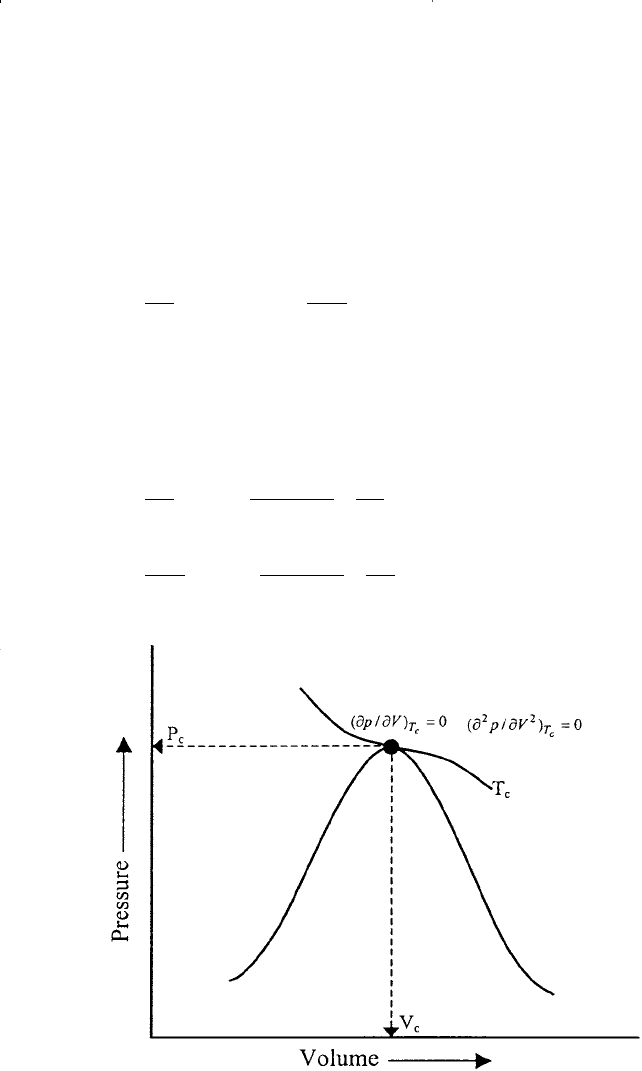Tarek Ahmed. Reservoir engineering handbook
Подождите немного. Документ загружается.


Example 15-7
A crude oil system has the following composition.
Component x
i
C
1
0.45
C
2
0.05
C
3
0.05
C
4
0.03
C
5
0.01
C
6
0.01
C
7+
0.40
If the molecular weight and specific gravity of C
7+
fractions are 215 and
0.87, respectively, calculate the density of the crude oil at 4000 psia and
160°F by using the Standing and Katz method.
Solution
Component x
i
M
i
m
i
= x
i
M
i
oi
, lb/ft
3
*V
i
= m
i
/
oi
C
1
0.45 16.04 7.218 — —
C
2
0.05 30.07 1.5035 — —
C
3
0.05 44.09 2.2045 31.64 0.0697
C
4
0.03 58.12 1.7436 35.71 0.0488
C
5
0.01 72.15 0.7215 39.08 0.0185
C
6
0.01 86.17 0.8617 41.36 0.0208
C
7+
0.40 215.0 86.00 54.288
†
1.586
m
t
= 100.253 V = 1.7418
* From Table 1-2.
†
= (0.87) (62.4) = 54.288.
Step 1. Calculate the weight percent of C
1
in the entire system and the
weight percent of C
2
in the ethane-plus fraction:
m
m
C
C
C
C
1
1
2
2
7 218
100 253
100 7 2
1 5035
100 253 7 218
100 1 616
(
)
=
=
(
)
=
−
=
+
+
.
.
.%
.
..
.%
C
7+
C
3+
1078 Reservoir Engineering Handbook
Reservoir Eng Hndbk Ch 15 2001-10-25 17:41 Page 1078

Step 2. Calculate the density of the propane-plus fraction:
Step 3. Determine the density of the oil at standard conditions from Fig-
ure 15-9:
Step 4. Correct for the pressure by using Figure 15-10:
Density of the oil at 4000 psia and 60°F is then calculated by the
expression:
Step 5. From Figure 15-11, determine the thermal expansion correction
factor:
Step 6. The required density at 4000 psia and 160°F is:
The Alani–Kennedy Method
Alani and Kennedy (1960) developed an equation to determine the
molar liquid volume V
m
of pure hydrocarbons over a wide range of tem-
perature and pressure. The equation was then adopted to apply to crude
oils with the heavy hydrocarbons expressed as a heptanes-plus fraction,
i.e., C
7+
.
The Alani–Kennedy equation is similar in form to the Van der Waals
equation, which takes the following form:
V
RT
p
bV
aV
p
ab
p
mm
m
32
0−+
+−=
(
)
15 - 43
ρ
0
3
48 68 2 45 46 23=−=.. ./lb ft
∆ρ
T
lb ft= 245
3
./
ρρρ
pscp
lb ft
,
.. . /
60
3
47 5 1 18 48 68=+ = + =∆
∆ρ
p
lb ft= 118
3
./
ρ
sc
lb ft= 47 5
3
./
ρ
C
lb ft
3
100 253 7 218 1 5035
1 7418
52 55
3
+
=
−−
=
...
.
./
Vapor–Liquid Phase Equilibria 1079
Reservoir Eng Hndbk Ch 15 2001-10-25 17:41 Page 1079

where R = gas constant, 10.73 psia ft
3
/lb-mol °R
T = temperature, °R
p = pressure, psia
V
m
= molecular volume, ft
3
/lb-mol
a, b = constants for pure substances
Alani and Kennedy considered the constants a and b to be functions of
temperature and proposed these expressions for calculating the two
parameters:
where K, n, m, and c are constants for each pure component. Values of
these constants are tabulated in Table 15-1. Table 15-1 contains no con-
stants from which the values of the parameters a and b for heptanes-plus
can be calculated. Therefore, Alani and Kennedy proposed the following
equations for determining a and b of C
7+
.
Table 15-1
Alani and Kennedy Coefficients
Components K n m 10
4
c
C
1
70° – 300°F 9,160.6413 61.893223 3.3162472 0.50874303
C
1
301° – 460°F 147.47333 3,247.4533 –14.072637 1.8326659
C
2
100° – 249°F 46,709.573 –404.48844 5.1520981 0.52239654
C
2
250° – 460°F 17,495.343 34.163551 2.8201736 0.62309877
C
3
20,247.757 190.24420 2.1586448 0.90832519
i – C
4
32,204.420 131.63171 3.3862284 1.1013834
n – C
4
33,016.212 146.15445 2.902157 1.1168144
i – C
5
37,046.234 299.62630 2.1954785 1.4364289
n – C
5
37,046.234 299.62630 2.1954785 1.4364289
n – C
6
52,093.006 254.56097 3.6961858 1.5929406
H
2
S* 13,200.00 0 17.900 0.3945
N
2
* 4,300.00 2.293 4.490 0.3853
CO
2
* 8,166.00 126.00 1.8180 0.3872
* Values for non-hydrocarbon components as proposed by Lohrenz et al. (1964).
aKe
bmTc
nT
=
=+
/
1080 Reservoir Engineering Handbook
Reservoir Eng Hndbk Ch 15 2001-10-25 17:41 Page 1080

where M = molecular weight of C
7+
= specific gravity of C
7+
a , b = constants of the heptanes-plus fraction
T = temperature in °R
For hydrocarbon mixtures, the values of a and b of the mixture are cal-
culated using the following mixing rules:
where the coefficients a
i
and b
i
refer to pure hydrocarbons at existing
temperature, and x
i
is the mole fraction in the mixture. The values of a
m
and b
m
are then used in Equation 15-43 to solve for the molar volume
V
m
. The density of the mixture at pressure and temperature of interest is
determined from the following relationship:
where
o
= density of the crude oil, lb/ft
3
M
a
= apparent molecular weight, i.e., M
a
= x
i
M
i
V
m
= molar volume, ft
3
/lb-mol
The Alani and Kennedy method for calculating the density of liquids is
summarized in the following steps:
ρ
o
a
m
M
V
=
aax
bbx
mii
i
C
mii
i
C
=
=
=
=
+
+
∑
∑
1
1
7
7
C
7+
C
7+
C
7+
C
7+
ln . .
.
..
...
.
aM
M
T
M
bM T
M
C
C
C
C
C
C
C
C
7
7
7
7
7
7
7
3 8405985 10 9 5638281 10
261 80818
7 3104464 10 10 753517
0 03499274 7 275403 2 232395 10
0 016322572
34
6
2
4
+
+
+
+
+
+
+
(
)
=
(
)
(
)
−
(
)
++
(
)
(
)
+
=
(
)
−
(
)
+
(
)
−
−−
−
−
γ
γ
γ
77
6 2256545
+
+ .
Vapor–Liquid Phase Equilibria 1081
Reservoir Eng Hndbk Ch 15 2001-10-25 17:41 Page 1081

Step 1. Calculate the constants a and b for each pure component from:
Step 2. Determine a and b .
Step 3. Calculate the values of coefficients a
m
and b
m
.
Step 4. Calculate molar volume V
m
by solving Equation 15-43 for the
smallest real root:
Step 5. Compute the apparent molecular weight, M
a
.
Step 6. Determine the density of the crude oil from:
Example 15-8
A crude oil system has the composition:
Component x
i
CO
2
0.0008
N
2
0.0164
C
1
0.2840
C
2
0.0716
C
3
0.1048
i – C
4
0.0420
n – C
4
0.0420
i – C
5
0.0191
n – C
5
0.0191
C
6
0.0405
C
7+
0.3597
The following additional data are given:
M = 252
= 0.8424
Pressure = 1708.7 psia
Temperature = 591°R
C
7+
C
7+
ρ
0
=
M
V
a
m
V
RT
p
bV
aV
p
ab
p
mmm
mm mm
32
0−+
+−=
C
7+
C
7+
aKe
bmTc
nT
=
=+
/
1082 Reservoir Engineering Handbook
Reservoir Eng Hndbk Ch 15 2001-10-25 17:41 Page 1082

Calculate the density of the crude oil.
Solution
Step 1. Calculate the parameters a and b :
Step 2. Calculate the mixture parameters a
m
and b
m
:
Step 3. Solve Equation 15-43 for the molar volume:
Step 4. Determine the apparent molecular weight of this mixture:
Step 5. Compute the density of the oil system:
ρ
ρ
0
0
3
113 5102
2 528417
44 896
=
==
M
V
lb ft
a
m
.
.
./
MxM
M
aii
a
=
=
Σ
113 5102.
V
RT
p
bV
aV
p
ab
p
V
mmm
mm mm
m
32
0
2 528417
−+
+−=
= .
aax
a
bbx
b
mii
i
C
m
mii
i
C
m
=
=
=
=
=
=
+
+
∑
∑
1
1
7
7
99111 71
2 119383
.
.
a
b
C
C
7
7
229269 9
4 165811
+
+
=
=
.
.
C
7+
C
7+
Vapor–Liquid Phase Equilibria 1083
Reservoir Eng Hndbk Ch 15 2001-10-25 17:41 Page 1083

EQUATIONS OF STATE
An equation of state (EOS) is an analytical expression relating the
pressure p to the temperature T and the volume V. A proper description of
this PVT relationship for real hydrocarbon fluids is essential in determin-
ing the volumetric and phase behavior of petroleum reservoir fluids and
in predicting the performance of surface separation facilities.
The best known and the simplest example of an equation of state is the
ideal gas equation, expressed mathematically by the expression:
where V = gas volume in cubic feet per 1 mol of gas. This PVT rela-
tionship is only used to describe the volumetric behavior of real hydro-
carbon gases at pressures close to the atmospheric pressure for which it
was experimentally derived.
The extreme limitations of the applicability of Equation 15-44 prompt-
ed numerous attempts to develop an equation of state (EOS) suitable for
describing the behavior of real fluids at extended ranges of pressures and
temperatures.
The main objective of this chapter is to review developments and
advances in the field of empirical cubic equations of state and demon-
strate their applications in petroleum engineering.
The Van der Waals Equation of State
In developing the ideal gas EOS (Equation 15-44), two assumptions
were made:
• First assumption: The volume of the gas molecules is insignificant
compared to the volume of the container and distance between the
molecules.
• Second assumption: There are no attractive or repulsive forces
between the molecules or the walls of the container.
Van der Waals (1873) attempted to eliminate these two assumptions by
developing an empirical equation of state for real gases. In his attempt
to eliminate the first assumption, van der Waals pointed out that the gas
molecules occupy a significant fraction of the volume at higher pres-
sures and proposed that the volume of the molecules, as denoted by the
p
RT
V
=
(
)
15 - 44
1084 Reservoir Engineering Handbook
Reservoir Eng Hndbk Ch 15 2001-10-25 17:41 Page 1084

parameter b, be subtracted from the actual molar volume V in Equation
15-44, to give:
where the parameter b is known as the co-volume and is considered to
reflect the volume of molecules. The variable V represents the actual vol-
ume in cubic feet per 1 mol of gas.
To eliminate the second assumption, van der Waals subtracted a cor-
rective term, as denoted by a/V
2
, from the above equation to account for
the attractive forces between molecules. In a mathematical form, van der
Waals proposed the following expression:
where p = system pressure, psia
T = system temperature, °R
R = gas constant, 10.73 psi-ft
3
/lb-mol = °R
V = volume, ft
3
/mol
The two parameters a and b are constants characterizing the molecular
properties of the individual components. The symbol a is considered a
measure of the intermolecular attractive forces between the molecules.
Equation 15-45 shows the following important characteristics:
1. At low pressures, the volume of the gas phase is large in comparison
with the volume of the molecules. The parameter b becomes negligi-
ble in comparison with V and the attractive forces term a/V
2
becomes
insignificant; therefore, the van der Waals equation reduces to the
ideal gas equation (Equation 15-44).
2. At high pressure, i.e., p →∞, volume V becomes very small and
approaches the value b, which is the actual molecular volume.
The van der Waals or any other equation of state can be expressed in a
more generalized form as follows:
where the repulsive pressure term p
repulsive
is represented by the term
RT/(V – b) and the attractive pressure term p
attractive
is described by a/V
2
.
pp p
repulsive attractive
=−
p
RT
Vb
a
V
=
−
−
(
)
2
15 - 45
p
RT
Vb
=
−
Vapor–Liquid Phase Equilibria 1085
Reservoir Eng Hndbk Ch 15 2001-10-25 17:41 Page 1085

In determining the values of the two constants a and b for any pure
substance, van der Waals observed that the critical isotherm has a hori-
zontal slope and an inflection point at the critical point, as shown in Fig-
ure 15-12. This observation can be expressed mathematically as follows:
Differentiating Equation 15-45 with respect to the volume at the critical
point results in:
Figure 15-12. An idealized pressure–volume relationship for a pure compound.
∂
∂
=
−
−
(
)
+=
(
)
∂
∂
=
−
(
)
+=
(
)
p
V
RT
Vb
a
V
p
V
RT
Vb
a
V
Tp
C
C
C
Tp
C
C
C
CC
CC
,
,
3
3
2
2
3
4
2
0
26
0
15 - 47
15 - 48
∂
∂
=
∂
∂
=
(
)
p
V
p
V
Tp
Tp
CC
CC
,
,
, 00
2
2
15 - 46
1086 Reservoir Engineering Handbook
Reservoir Eng Hndbk Ch 15 2001-10-25 17:41 Page 1086

Solving Equations 15-47 and 15-48 simultaneously for the parameters a
and b gives:
Equation 15-49 suggests that the volume of the molecules b is approxi-
mately 0.333 of the critical volume V
C
of the substance. Experimental
studies reveal that the co-volume b is in the range of 0.24 to 0.28 of the
critical volume and pure component.
By applying Equation 15-45 to the critical point (i.e., by setting T = T
c
,
p = p
c
, and V = V
c
) and combining with Equations 15-49 and 15-50, we get:
Equation 15-51 shows that regardless of the type of substance, the van
der Waals EOS produces a universal critical gas compressibility factor Z
c
of 0.375. Experimental studies show that Z
c
values for substances range
between 0.23 and 0.31.
Equation 15-51 can be combined with Equations 15-49 and 15-50 to
give a more convenient and traditional expression for calculating the
parameters a and b to yield:
where R = gas constant, 10.73 psia-ft
3
/lb-mol-°R
p
c
= critical pressure, psia
T
c
= critical temperature, °R
Ω
a
= 0.421875
Ω
b
= 0.125
a
RT
p
b
RT
p
a
c
c
b
c
c
=
(
)
=
(
)
Ω
Ω
22
15 - 52
15 - 53
pV RT
CC C
=
(
)
(
)
0 375.15-51
bV
aRTV
C
CC
=
(
)
=
(
)
1
3
8
9
15 - 49
15 - 50
Vapor–Liquid Phase Equilibria 1087
Reservoir Eng Hndbk Ch 15 2001-10-25 17:41 Page 1087
